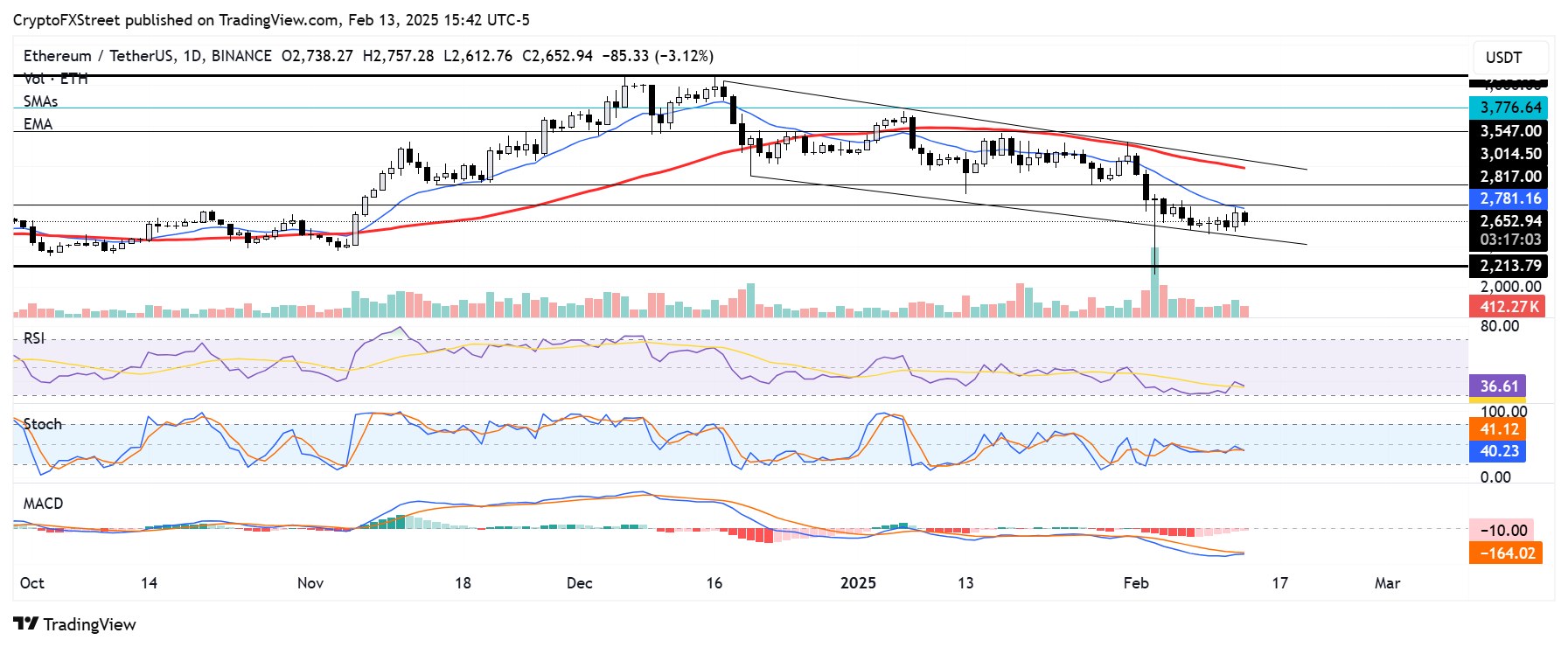Ethereum Price Forecast: ETH face rejection at $2,817 despite Ethereum Foundation's $120 million DeFi move
Ethereum price today: $2,650
- The Ethereum Foundation deployed nearly $120 million across Aave, Compound and MakerDAO's Spark.
- Cboe filed with the SEC for 21Shares to allow staking within its Ethereum ETF.
- Ethereum suffers another rejection at $2,817 as a lack of price catalyst fuels market consolidation.
Ethereum (ETH) is down 1% on Thursday after experiencing another rejection at the $2,817 support level. The Ethereum Foundation's capital allocation to several decentralized finance (DeFi) protocols failed to catalyze ETH's price as the crypto market remains subdued by macroeconomic factors.
Ethereum Foundation allocates 45,000 ETH to DeFi protocols
The Ethereum Foundation (EF) announced that it has deployed 45,000 ether (ETH), worth approximately $120 million, into several DeFi protocols.
The Foundation allocated 30,800 ETH to Aave, one of the largest DeFi lending platforms, with 20,800 ETH going to Aave's Core market and 10,000 ETH to Aave Prime.
Additionally, the Foundation allocated 10,000 ETH to Spark, a lending protocol within the MakerDAO ecosystem. It also sent 4,200 ETH to Compound, another leading DeFi lending platform.
EF Treasury has deployed:
— Ethereum Foundation (@ethereumfndn) February 13, 2025
- 10,000 ETH into Spark
- 10,000 ETH into Aave Prime
- 20,800 ETH into Aave Core
- 4,200 ETH into Compound
We're grateful for the entire Ethereum security community that has worked diligently to make Ethereum DeFi secure and usable!
The EF could potentially earn around $1.8 million — based on current prices and an average annual 1.5% yield — from its position across these protocols. As a result, it enhances the value of its Treasury without liquidating holdings.
The EF's foray into DeFi yield farming comes after criticism from crypto community members.
Several community members alleged that the Foundation only uses the Ethereum blockchain to sell the assets in its Treasury. Other key figures alleged that the Foundation does not actively support protocols and dApps.
In response, the EF announced that it would deploy about 50,000 to various protocols to support DeFi activities on the Ethereum mainnet.
Meanwhile, the Cboe filed with the Securities & Exchange Commission (SEC) for asset manager 21Shares to allow staking within the 21Shares Core Ethereum ETF (CETH). If approved, staking could make ETH ETFs attractive to users and significantly boost their inflows. (Link to it.)
Banking firm Standard Chartered had predicted that ETH could rally to $14,000 by year-end if the SEC approves staking for ETH ETFs.
Ethereum Price Forecast: ETH suffers another rejection at $2,817
Ethereum saw $37.29 million in futures liquidations in the past 24 hours, per Coinglass data. The total amount of long and short liquidations accounted for $22.02 million and $15.28 million, respectively.
ETH saw another rejection at the $2,817 support level, strengthened by the 14-day Exponential Moving Average (EMA). The top altcoin could find support at the lower boundary of a descending channel following the rejection.

ETH/USDT daily chart
If ETH sustains a high volume move above $2,817 and establishes it as a key support level, it could test the descending channel's upper boundary resistance. A firm decline below the channel's support could send ETH toward the $2,200 level.
The top altcoin's current move mirrors that of the wider crypto market, where prices have moved largely horizontally.
The crypto market needs a catalyst, or ETH will likely remain range-bound below $2,817. This level proved a critical barrier to overcome the last time ETH declined below it following Israel-Hamas war tension in August. It took a huge catalyst like President Trump's election win to lift ETH above this level after a four-month consolidation.
The Relative Strength Index (RSI) and Stochastic Oscillator (Stoch) are below their neutral levels, signaling dominant bearish momentum.
The Moving Average Convergence Divergence (MACD) tests its moving average red line and posts receding histogram bars, indicating that the underlying bearish momentum is weakening.
A daily candlestick close below $2,200 will invalidate the thesis.
Ethereum FAQs
Ethereum is a decentralized open-source blockchain with smart contracts functionality. Its native currency Ether (ETH), is the second-largest cryptocurrency and number one altcoin by market capitalization. The Ethereum network is tailored for building crypto solutions like decentralized finance (DeFi), GameFi, non-fungible tokens (NFTs), decentralized autonomous organizations (DAOs), etc.
Ethereum is a public decentralized blockchain technology, where developers can build and deploy applications that function without the need for a central authority. To make this easier, the network leverages the Solidity programming language and Ethereum virtual machine which helps developers create and launch applications with smart contract functionality.
Smart contracts are publicly verifiable codes that automates agreements between two or more parties. Basically, these codes self-execute encoded actions when predetermined conditions are met.
Staking is a process of earning yield on your idle crypto assets by locking them in a crypto protocol for a specified duration as a means of contributing to its security. Ethereum transitioned from a Proof-of-Work (PoW) to a Proof-of-Stake (PoS) consensus mechanism on September 15, 2022, in an event christened “The Merge.” The Merge was a key part of Ethereum's roadmap to achieve high-level scalability, decentralization and security while remaining sustainable. Unlike PoW, which requires the use of expensive hardware, PoS reduces the barrier of entry for validators by leveraging the use of crypto tokens as the core foundation of its consensus process.
Gas is the unit for measuring transaction fees that users pay for conducting transactions on Ethereum. During periods of network congestion, gas can be extremely high, causing validators to prioritize transactions based on their fees.

